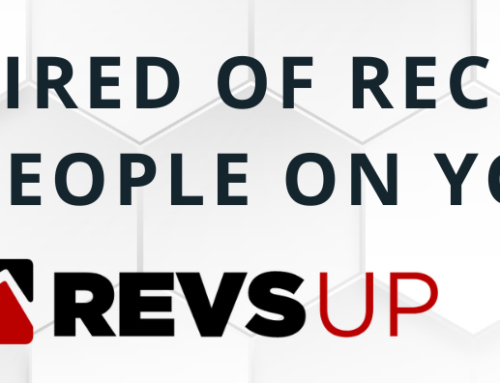
Salespeople are a savvy bunch, and they are always asking themselves this critical question: am I in the optimal position to maximize my earnings potential, and am I passionate about my boss, my company, and the product I’m representing? Top performers make a move when they experience significant changes in their comp plan, territory, leadership, products, etc. We’ve covered much of this here and here.
When making a career change, the majority of salespeople I interact with are looking to move to a company that sells a similar software product, to the near-exact same Buyer Titles and Industries as their current company.
It makes sense. If you’ve spent 5+ years gaining a deep understanding of CMO’s challenges, opportunities, purchasing behavior, etc., it’s logical to make use of that institutional knowledge by continuing your career in that same general space – in this case, marketing technology. It’s also the easiest move to make and you probably have passion for this space.
Today’s article is aimed at Enterprise salespeople (software or other) who are looking to make a significant change in what I will call their “sales focus”.
If we created a “levels of difficulty” rating for salespeople making hypothetical career switches, it might look like this:
* Moving to a software company that sells a similar product, to the exact same Buyer Titles and Industries.
** Moving to a software company that sells to Buyer Titles and ICPs that you’ve never sold to.
*** Moving from a non-software sales company to a software sales company.
**** Trying to get a sales job with no sales experience.
If you’re in Group 2, if you will, you’ve sold into a specific Buyer Title / Industry (IT, healthcare, advertising, operations, government, channels, etc.) for 5-10 consecutive years and now you’d like to sell to a brand-new group of buyers.
If you’re in Group 3, you’ve sold non-software (hardware, financial service products, IT services, consulting, advertising, hard goods, telecom, healthcare products, etc.), and now you’d like to sell software.
Due to the inherent challenges in making a more dramatic sales focus switch, I believe these sales candidates (both ICs and leaders) should take a unique approach to their search.
I’ve always had a great deal of interest in this topic personally:
- I changed my own sales focus four times;
- As a hiring manager, I hired a couple dozen salespeople who were changing focuses;
- As a contingent sales recruiter, I hear from this group every week. I don’t track my activity to this level, but I’m pretty certain that 30% to 40% of the Candidate inquires I receive each week are from individuals not currently selling software, who want to. Or currently selling to Buyer Titles or Industries outside of my speciality (MarTech, SalesTech, CX, HRTech).
So, perhaps 1 or 2 of these tips might help you make the move. Unlike my previous posts, these are NOT necessarily listed in order of importance.
1. Treat this like the most challenging sale you’ve ever had to close
This is not going to be easy. Think of what it took to close your largest or most complex deal ever – the blueprinting, prospecting, networking, creativity, persistence, messaging, consensus-building, follow-up, written/verbal communication skills, and close plans.
You’re going to need to excel in many of these areas to make this switch, and candidly it’s going to be challenging to find the time execute this properly.
2. Figure out where you want to work
If you want to move from non-software sales to software, or to sell to a new Buyer Title / Industries, you should build a target list of the companies or types of companies that you’re passionate about. So don’t say, “I want to sell into Marketing Tech” – that’s 1,500+ companies. Focus on a subcategory: mobile, social, AI, personalization, customer experience, analytics, customer intelligence, marketing automation, sales enablement, e-commerce technology. Get to a list of 25-50 – this seems manageable.
After our adtech startup was acquired by eBay Enterprises in 2011, I figured out that I really wanted to move into software sales, and specifically e-commerce personalization software. Up until then I had never closed a single SaaS deal. So I blueprinted the top 30 companies in e-commerce personalization, reached out to 30 VPs of Sales, entered into four interview processes, and accepted a role with one of the four.
Of note: I had already left eBay, and basically worked 25 hours a week for 4 consecutive weeks to achieve this outcome.
3. Activate your network
Once you have your target list … do you know anyone working there currently? How about previously? It doesn’t have to be a sales leader or CEO, it could be any employee with any title. Use these contacts to learn more about the current makeup of the sales team, their hiring process, the hiring manager, culture, etc. Any and all insider information goes a long way when trying to get the attention of a VP of Sales.
4. Use highly personalized emails
Your VP of Sales prospecting emails / letters / voicemails / InMails should be “buyer-centric” (just like the prospecting you do now, right?). There are a ton of brand-name methodologies out there (Basho, Kensei) if you need some retraining on this, but this article provides a couple of good examples.
5. You are only seeking a 15-minute call, not a job offer
All of your prospecting activities should have a single goal – to secure a 15-minute phone conversation with the VP of Sales. If you achieve a better outcome (30-minute phone call, official first interview), good on you. But the 15-minute phone call a) is achievable; b) respects your target’s time; and c) is all any Top 10 salesperson needs to crack open a promising opportunity.
6. Upgrade your resume – by creating a sales portfolio
I understand the reticence to deliver any document that is seven pages long, but hear me out. The materials you present to a VP of Sales fall into one of two categories: a) what you say you have done; and b) empirical evidence that supports (if not validates) your claims. So, the 1-page resume outlines all your achievements (and gets rid of all fluff!), and you’re simply using an Appendix, if you will, to provide more detail about those achievements.
These documents could include letters of recommendation, annual reviews, W2s, customer logos, leadership accomplishments, LIN recommendations, reading lists, volunteer achievements, President’s Club stuff, business plans, etc.
When I was a hiring manager, my reaction to a candidate who included these items was: “Hmm, these people / customers / organizations sure seem to have good things to say about Bill. If that’s accurate, maybe he’s someone I should speak with.” Make sure that you’re not sharing anything that would violate any non-compete or confidentiality agreements, of course.
7. Accept a cut in base salary
If you’re really, really good, you can match your current base when making a major shift in focus. But imagine being so confident in your abilities that you advertise your willingness to take a cut. Hey, you always exceed quota, so you’ll make it up on the back end, right? That line might get someone’s attention.
When I first started at Findly, I met with one of our operations leaders – he led a team of 6-8 people, but had never held a sales role in his life. I thought the guy could be a stud and tried to convince him to try sales. Oh, and he had to take a $25k base cut for the pleasure. Thankfully for both of us, he did, and he notched a $400k W-2 in his first year ever in sales.
8. Relocate first
I often read, “I’ll relocate almost anywhere for the right opportunity.” Strong stance, and this by definition improves your odds. However, I have observed among my client base a reluctance to engage with candidates who haven’t already relocated to the client’s preferred city. We all know that with physical relocation comes plenty of minor headaches – hiring managers see these as distractions. And quite frankly, there are enough A Player Individual Contributors in any given city that there’s no huge upside in relocating someone. (This advice is for ICs; leadership roles are somewhat different).
9. Don’t rely on staffing agencies or internal HR recruiters
Contingent recruiters (staffing agencies) and internal recruiters are often held to a rigid range of acceptable candidate profiles. They’re required to produce top-level candidates who have sold similar software to the same Buyer Profile / Industry. In other words, our clients demand “Group 1” candidates.
For both internal and external recruiters, it’s a numbers game. For instance, I allocate 40 time slots a week into for candidate interviews – 8 a day. Those 40 slots are the lifeblood of my business, and as such I need to speak with 40 individuals whom can I can realistically place at one my current openings over the next 6 to 8 weeks. The same is true for a company’s internal recruiters.
I mentioned earlier that I switched sales focus four times (print advertising, digital advertising, AdTech, MarketingTech) … all of these roles were secured through direct VP of Sales outreach.
If you’re reading this and you’ve made a major shift yourself, please share any tips and tricks in the comments!
Other resources about changing sales careers:









Number 5 is exactly how I train my SDRs when they are struggling. I explain to them stop trying to close them on our solutions and focus on the benefits of having a quick call. Close the call not the deal. Awesome insights here.